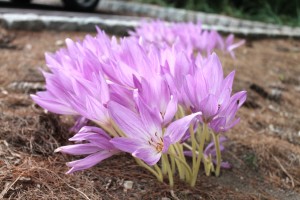Autumn crocus
* Common name: Autumn crocus

Notice the lack of leaves on the blooming stems of these autumn crocus.
* Botanical name: Colchicum autumnale
* What it is: An unusual bulb (technically a corm) that sends up foot-tall, lance-leafed green leaves in spring, then dies back over summer, then sends up leafless stems in late summer that produce tubular crocus-like flowers of violet to lavender-pink (sometimes white). Corms are toxic, which explains why deer don’t eat them.
* Size: Spring foliage grows 12 inches tall. Fall flower stems grow 6 inches tall. Space corms 4 to 6 inches apart.
* Where to use: Plant in clusters in a backyard border bed or under a limbed-up tree. Not a great choice in a front-and-center bed because the leaves will go yellow for a few weeks in spring and then disappear altogether through summer. Will gradually colonize over time. Prefers full sun to light shade.
* Care: Autumn crocus are best planted in August, when they’ll flower that fall. Or plant in fall for a new cycle the following spring. Prefers loose, well drained soil or raised beds – no sogginess. Scatter an organic, granular bulb fertilizer over the bed in early spring and early fall each year to maximize performance. Let foliage die back naturally in spring; do not cut it while green. Dead flower stalks can be raked off any time from late fall to end of winter. Corms can be dug and divided while dormant in summer.
* Great partners: Set a few flower pots of summer annuals over the bare bed in summer, but be sure to remove it by mid-August to allow the autumn crocus flower shoots to emerge.







